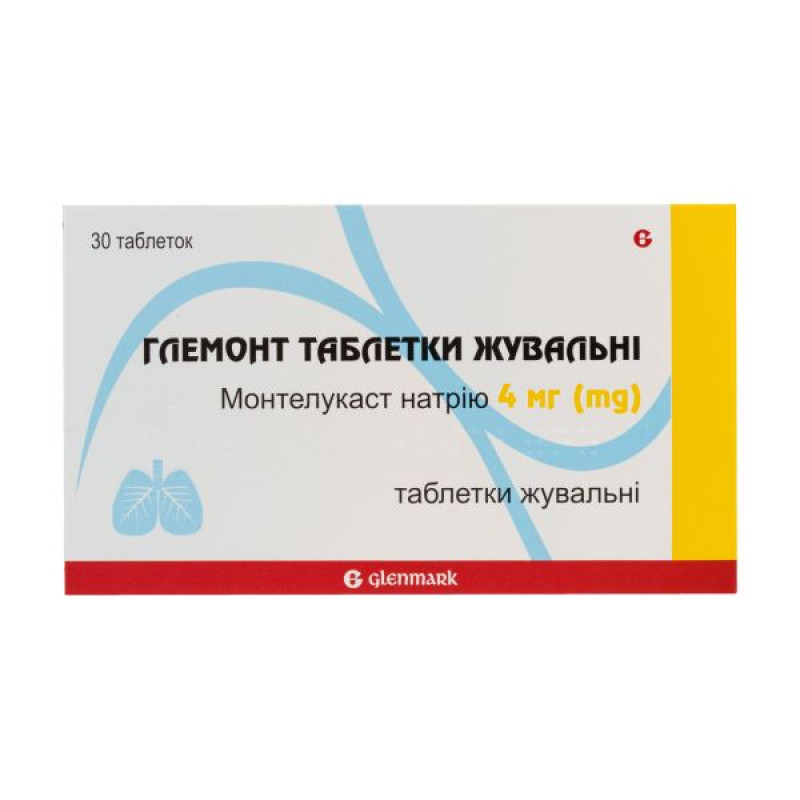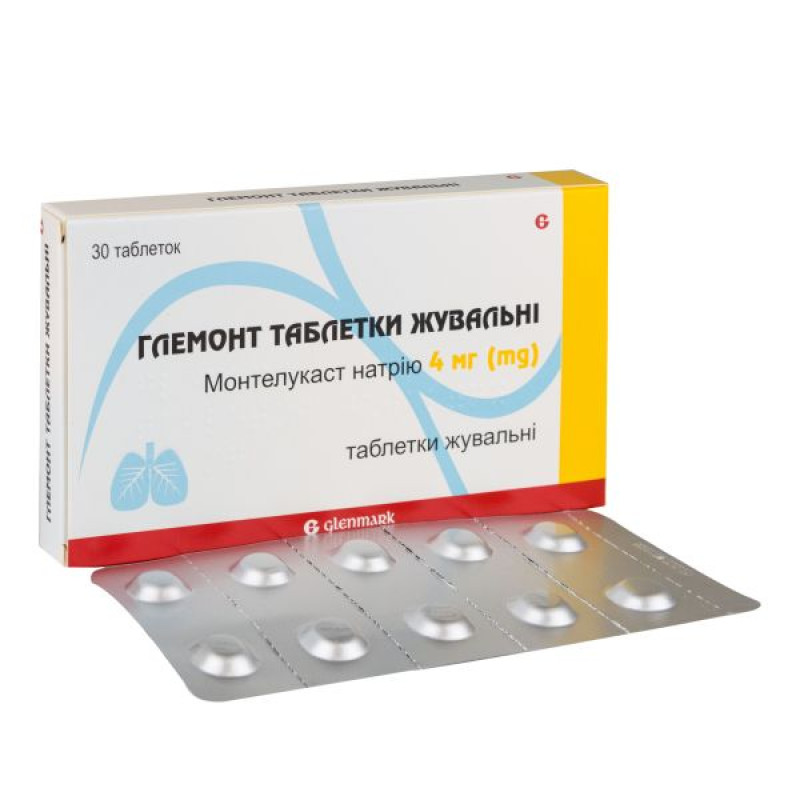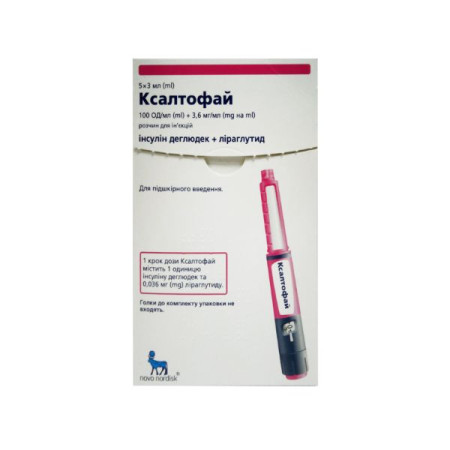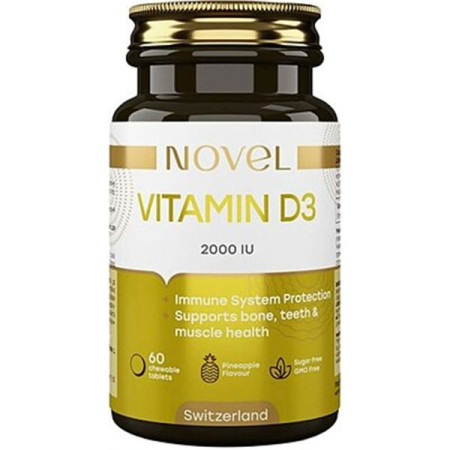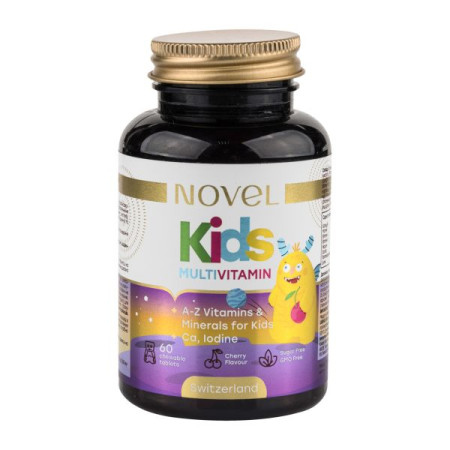Glemont chewable tablets 4 mg blister No. 30
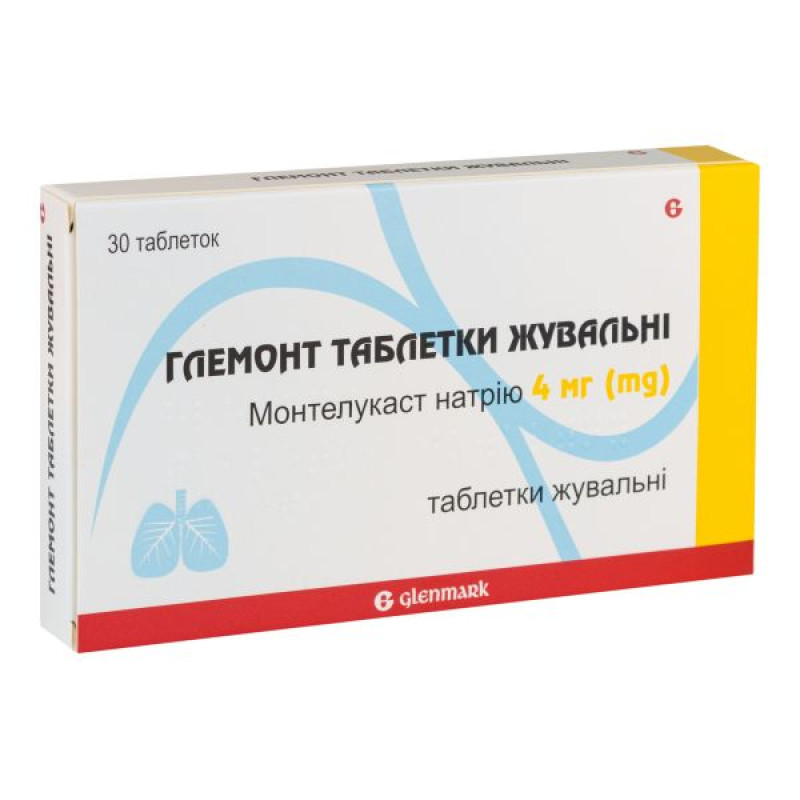
Instructions for use Glemont chewable tablets 4 mg blister No. 30
Composition
active ingredient: montelukast;
1 tablet contains montelukast sodium equivalent to montelukast 4 mg or 5 mg;
excipients: microcrystalline cellulose, mannitol (E 421), croscarmellose sodium, hydroxypropylcellulose, magnesium stearate, aspartame (E 951), cherry flavoring.
Dosage form
Chewable tablets.
Main physicochemical properties:
4 mg chewable tablets: oval, white or almost white, biconvex tablets engraved with “G” on one side and “390” on the other side;
5 mg chewable tablets: round, white or almost white, biconvex tablets engraved with “G” on one side and “391” on the other side.
Pharmacotherapeutic group
Antiasthmatic drugs for systemic use. Leukotriene receptor antagonists.
ATX code R03D C03.
Pharmacological properties
Pharmacodynamics.
Cysteinyl leukotrienes (LTC4, LTD4, LTE4) are potent inflammatory eicosanoids secreted by various cells, including mast cells and eosinophils. These important pro-asthmatic mediators bind to cysteinyl leukotriene receptors (CysLT) present in the human airways and induce responses such as bronchospasm, sputum production, vascular permeability, and eosinophil recruitment.
Montelukast is an active compound that binds with high selectivity and chemical affinity to CysLT1 receptors. Montelukast produces significant blockade of airway cysteinyl leukotriene receptors, as demonstrated by its ability to inhibit LTD4-induced bronchoconstriction in asthmatic patients. Even a low dose of 5 mg produces significant blockade of LTD4-induced bronchoconstriction. Montelukast produces bronchodilation within 2 hours after oral administration; this effect was additive to that produced by β-agonists.
Treatment with montelukast suppresses both early and late-stage bronchospasm, reducing the response to antigens. Montelukast reduces peripheral blood eosinophil counts compared with placebo in adults and children. In a separate study, montelukast significantly reduced airway eosinophil counts (as measured in sputum). In adults and children 2 to 14 years of age, montelukast reduces peripheral blood eosinophil counts and improves clinical control of asthma compared with placebo.
Pharmacokinetics.
Absorption
After oral administration, montelukast is rapidly and almost completely absorbed. After administration of a 5 mg chewable tablet in the fasted state, Cmax in adults is reached after 2 hours. Bioavailability was 73% and decreased to 63% with regular food intake.
Distribution
Montelukast is more than 99% bound to plasma proteins. The steady-state volume of distribution of montelukast averages 8 to 11 liters. In studies of radiolabeled montelukast, penetration of the blood-brain barrier was minimal. In all other tissues, radiolabeled material concentrations were also minimal 24 hours after dosing.
Metabolism
Montelukast is extensively metabolized. Steady-state plasma concentrations of montelukast metabolites have not been determined in studies with therapeutic doses in adults and pediatric patients.
In vitro studies using human liver microsomes have shown that cytochromes P450 3A4, 2A6, and 2C9 are involved in the metabolism of montelukast. Further in vitro studies using human liver microsomes have shown that at therapeutic concentrations, montelukast does not inhibit cytochromes P450 3A4, 2C9, 1A2, 2A6, 2C19, and 2D6. The contribution of metabolites to the therapeutic effects of montelukast is minimal.
Breeding
The plasma clearance of montelukast in healthy adult volunteers averages 45 mL/min. Following an oral dose of radiolabeled montelukast, 86% is excreted in the feces within 5 days and less than 0.2% in the urine. This, together with the oral bioavailability of montelukast, indicates that its metabolites are almost entirely excreted in the bile.
Pharmacokinetics in different patient groups
No dose adjustment is necessary for patients with mild to moderate hepatic impairment. Studies in patients with renal impairment have not been conducted. Since montelukast and its metabolites are excreted in the bile, dose adjustment is not considered necessary for patients with renal impairment. There are no data on the pharmacokinetics of montelukast in patients with severe hepatic impairment (Child-Pugh score greater than 9).
A decrease in plasma theophylline concentrations has been observed at high doses of montelukast (20 and 60 times the recommended adult dose). This effect is not observed at the recommended dose of 10 mg once daily.
Pharmacokinetic studies have shown that the concentration profiles of the 4 mg chewable tablets in children aged 2 to 5 years and the 5 mg chewable tablets in children aged 6 to 14 years are similar to the concentration profile of the 10 mg film-coated tablets in adults.
The 5 mg chewable tablets should be used for patients aged 6 to 14 years, and the 4 mg chewable tablets should be used for patients aged 2 to 5 years.
Indication
Montelukast 4 mg chewable tablets are recommended for children aged 2 to 5 years;
Montelukast 5 mg chewable tablets are recommended for children aged 6 to 14 years:
- as an additional treatment for bronchial asthma in patients with mild to moderate persistent asthma, inadequately controlled by inhaled corticosteroids, as well as with insufficient clinical control of asthma with short-acting β-agonists used as needed;
- as an alternative treatment to low-dose inhaled corticosteroids for patients with mild persistent asthma who have not had a recent serious asthma attack requiring oral corticosteroids, and for those patients who are intolerant to inhaled corticosteroids;
- as a prevention of asthma, the dominant component of which is exercise-induced bronchospasm;
- to relieve symptoms of seasonal and perennial allergic rhinitis.
Contraindication
Hypersensitivity to any of the components of the drug.
Interaction with other medicinal products and other types of interactions
Montelukast can be administered with other drugs for the prevention or long-term treatment of asthma. In drug-drug interaction studies, the recommended clinical dose of montelukast had no clinically significant effect on the pharmacokinetics of the following drugs: theophylline, prednisone, prednisolone, oral contraceptives (ethinylestradiol/norethindrone 35/1), terfenadine, digoxin, and warfarin.
In patients receiving concomitant phenobarbital, the area under the concentration-time curve (AUC) of montelukast was decreased by approximately 40%. Since montelukast is metabolized by CYP3A4, caution should be exercised, especially in children, when montelukast is administered concomitantly with CYP3A4 inducers, such as phenytoin, phenobarbital, and rifampicin.
In vitro studies have shown that montelukast is a potent inhibitor of CYP 2C8. However, data from a clinical drug interaction study involving montelukast and rosiglitazone (a drug metabolized by CYP 2C8) have shown that montelukast is not an inhibitor of CYP 2C8 in vivo. Therefore, montelukast does not significantly affect the metabolism of drugs metabolized by this enzyme (e.g., paclitaxel, rosiglitazone, and repaglinide).
Application features
Patients should be advised that Montelukast should not be used for the relief of acute asthma attacks. It is recommended that appropriate reliever medication be continued. In the event of an acute attack, a short-acting inhaled beta-agonist should be used. Patients should consult their doctor as soon as possible if they require more inhalations of a short-acting β-agonist than usual.
Montelukast therapy should not be abruptly replaced with inhaled or oral corticosteroid medications.
In isolated cases, patients receiving anti-asthma drugs, including montelukast, may experience systemic eosinophilia, sometimes with clinical manifestations of vasculitis, the so-called Churg-Strauss syndrome (granulomatous allergic angiitis), which is treated with systemic corticosteroid therapy. Such cases have usually been associated with a reduction or discontinuation of corticosteroid therapy. The assumption that leukotriene receptor antagonists may be associated with the development of Churg-Strauss syndrome cannot be refuted or confirmed, so physicians should be warned about the possibility of eosinophilia, vasculitic rash, worsening pulmonary symptoms, complications from the cardiac system and/or neuropathy in patients. Patients who develop the above symptoms should be re-examined and their treatment regimen should be reviewed.
Glemont chewable tablets contain aspartame, which is a derivative of phenylalanine and is dangerous for patients with phenylketonuria.
General recommendations for the use of the drug.
The therapeutic effect of the drug on asthma control persists throughout the day. Patients should be advised to continue taking the drug even when asthma is controlled, as well as during exacerbations of status asthmaticus.
No dose adjustment is required for patients with mild to moderate hepatic impairment or renal impairment. There are no data on the pharmacokinetics of montelukast in patients with severe hepatic impairment (Child-Pugh score greater than 9), and therefore no dose adjustment recommendations are available.
The dosage of the drug is the same for male and female patients.
Montelukast is not recommended as monotherapy in patients with moderate persistent asthma. Montelukast should be used as an alternative to low-dose inhaled corticosteroids in children with mild persistent asthma only in patients without a recent history of severe asthma attacks requiring oral corticosteroids and in patients who cannot take inhaled corticosteroids.
Mild persistent asthma is asthma in which asthma symptoms occur more than once a week but less than once a day, nocturnal attacks occur more than twice a month but less than once a week, and lung function remains normal between episodes. If satisfactory asthma control cannot be achieved (usually within 1 month), the need for additional or different anti-inflammatory therapy should be assessed, based on a stepwise asthma management system. Patients should have their asthma control assessed periodically.
Use of montelukast before exercise to prevent asthma attacks.
In patients 2 to 5 years of age, exercise-induced bronchospasm may be the primary symptom of persistent asthma requiring treatment with inhaled corticosteroids. The patient should be reevaluated 2 to 4 weeks after initiation of montelukast therapy. If there is no satisfactory response, a decision should be made regarding additional or alternative therapy.
Montelukast treatment compared with other asthma treatments. If montelukast treatment is given as add-on therapy to inhaled corticosteroid treatment, montelukast should not be abruptly substituted for inhaled corticosteroids.
Use during pregnancy or breastfeeding
The drug is intended for use in children.
The ability to influence the reaction speed when driving or working with other mechanisms
The drug is intended for use in children.
Method of administration and doses
The drug should be used by children under adult supervision.
Children aged 2 to 5 years.
For patients with asthma and allergic rhinitis (seasonal and perennial), the recommended dose is 1 chewable tablet of 4 mg once daily.
Children aged 6 to 14 years.
For patients with asthma and allergic rhinitis (seasonal and perennial), the recommended dose is 1 chewable tablet of 5 mg once daily.
For the treatment of asthma, the chewable tablet should be taken in the evening 1 hour before or 2 hours after a meal. For the relief of symptoms of allergic rhinitis, the time of administration is selected individually.
Individual dose selection for this age category is not required.
For patients aged 15 years and older, the recommended dosage is 10 mg montelukast tablets.
Children
It is used in children from 2 years of age. Children from 6 months to 2 years of age are given the drug in the form of 4 mg granules.
Overdose
There is no information on the treatment of overdose with montelukast. In chronic asthma studies, montelukast has been administered at doses up to 200 mg/day to adult patients for 22 weeks, and in short-term studies, up to 900 mg/day for approximately one week, without clinically significant adverse reactions.
In post-marketing use and during clinical trials, there have been reports of acute overdose of montelukast in adults and children at doses exceeding 1000 mg (approximately 61 mg/kg, child aged 42 months). The clinical and laboratory data obtained were consistent with the safety profile in adult patients and children.
In most overdose reports, adverse events were consistent with the safety profile of montelukast and included abdominal pain, drowsiness, thirst, headache, vomiting, and psychomotor hyperactivity.
It is not known whether montelukast is removed by peritoneal dialysis or hemodialysis. Treatment is symptomatic.
Adverse reactions
Adverse reactions reported during clinical trials with a frequency of ≥ 1/100 to < 1/10:
infections and invasions: upper respiratory tract infections;
from the nervous system: headache;
Gastrointestinal: abdominal pain;
general disorders: thirst.
Adverse reactions reported in the post-marketing period:
from the circulatory and lymphatic system: tendency to increased bleeding;
Immune system disorders: hypersensitivity reactions, including anaphylaxis, eosinophilic infiltration of the liver;
on the part of the psyche: sleep disorders, including nightmares, hallucinations, insomnia, irritability, anger, impatience, agitation, including aggressive behavior or hostility, tremor, depression, disorientation, very rarely - suicidal thoughts and behavior;
from the nervous system: lethargy and dizziness, paresthesia/hypoesthesia, seizures;
Cardiovascular system: feeling of palpitations;
Gastrointestinal: diarrhea, dry mouth, dyspepsia, nausea, vomiting;
Skin and subcutaneous tissue disorders: angioedema, hematoma, urticaria, itching, rash, erythema nodosum;
Musculoskeletal and connective tissue disorders: arthralgia, myalgia, including muscle cramps;
general disorders and local reactions: asthenia/fatigue, feeling of discomfort, swelling, fever.
In isolated cases, epistaxis and Churg-Strauss syndrome (CSS) have been reported in patients with asthma treated with montelukast (see section "Special warnings and precautions for use").
Expiration date
2 years.
Storage conditions
Store in a dry place, protected from light, at a temperature not exceeding 25 °C.
Keep out of reach of children.
Packaging
10 tablets in a blister, 3 blisters in a cardboard box.
30 tablets in a plastic container, in a cardboard box. A polymer cylinder with a desiccant (silica gel) is placed in each container along with the tablets.
Vacation category
According to the recipe.
Producer
Glenmark Pharmaceuticals Ltd. / Glenmark Pharmaceuticals Ltd.
Location of the manufacturer and its business address
Village Kishanpura, Baddi-Nalagarh Road, Tehsil Nalagarh, Disst. Solan (HP) 174101, India.
There are no reviews for this product.
There are no reviews for this product, be the first to leave your review.
No questions about this product, be the first and ask your question.







